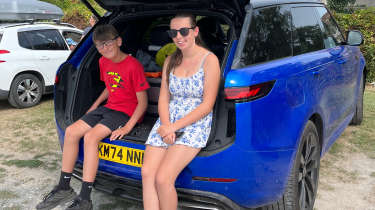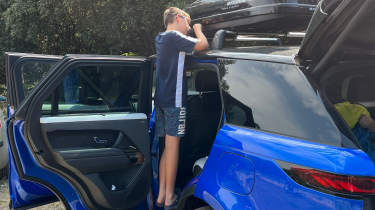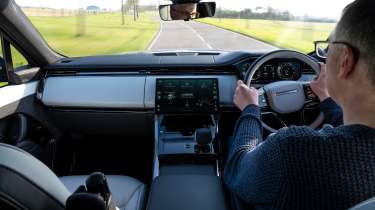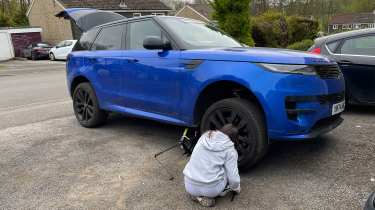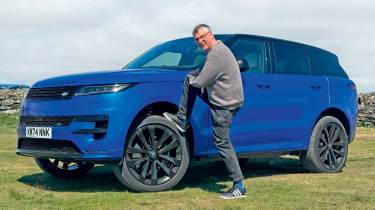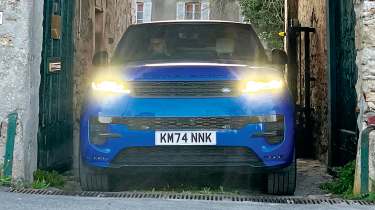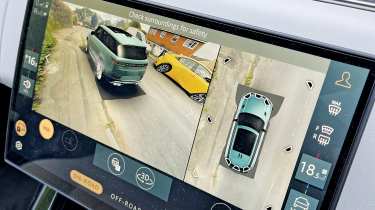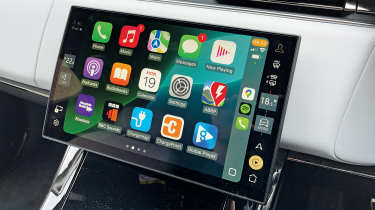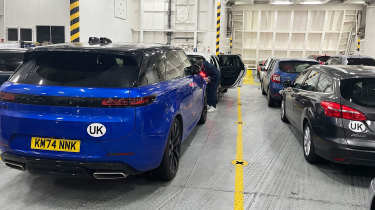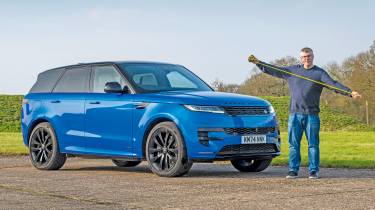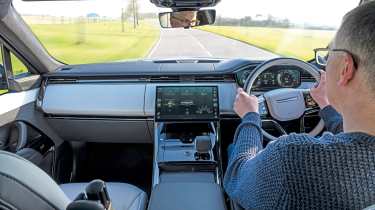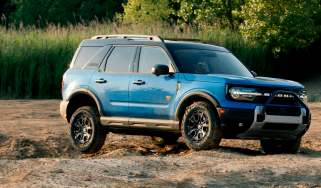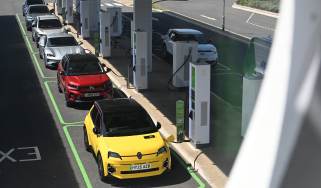Long-term test: Range Rover Sport P550e Autobiography
Final report: It’s a grand finale for our PHEV as we take it to the south of France

Verdict
The Range Rover Sport is a supremely talented, if really pricey, all-rounder, and while the PHEV powertrain isn’t that efficient thanks to the bulk it has to lug around, it gives you the best of both worlds in this 542bhp P550e form. It’s got excellent passenger space in that classy interior and feels every inch the proper premium product.
- Mileage: 11,468 miles
- Efficiency: 38.5mpg
Spending a condensed amount of time in a car is a great way to really unearth its strengths and weaknesses. So a two-week, 1,200-mile late-summer break absolutely loaded to the gills, with a roofbox on top plus four bikes strapped securely to the rear, was a fitting final test for a car that has now sadly left our fleet.
I’ve run electric vehicles for the past couple of years, so the major point of running the plug-in Range Rover Sport was to see if a modern PHEV fits my life better or worse than an EV.
My previous long-term experience of plug-in hybrids dates back to PHEVs with a range of 20-ish miles, but the Range Rover is part of a new breed that can manage more than 50 miles in the real world – its official test figure is 72 miles. This makes longer electric-only journeys possible – or at least stretches out the distance that’s possible before the electric motor kicks in. And stretching that is important when it’s not the most efficient of engines, thanks to that 3.0-litre engine under the bonnet boasting 542bhp to make for a sub-five-second 0-62mph time.
Used - available now

2022 Land Rover
Range Rover Sport
50,560 milesAutomaticPetrol2.0L
Cash £31,621
2022 Land Rover
Range Rover Sport
55,874 milesAutomaticPetrol3.0L
Cash £31,614
2020 Land Rover
Range Rover Sport
58,492 milesAutomaticDiesel4.4L
Cash £35,344
2022 Land Rover
Range Rover Sport
68,860 milesAutomaticDiesel3.0L
Cash £33,584The Range Rover Sport’s final hurrah on our fleet got us from our Sussex home as far as the Portsmouth ferry terminal on battery power alone, and just about through the tedious hour-long queue for passport control in Caen. But from then on, the petrol engine was on its own for more than 1,000 miles, because we couldn’t charge where we were staying, and public charging prices mean topping up a PHEV won’t save enough money to be worth the time.
Our average economy – with the car fully loaded at French autoroute speeds or pootling around town and to the beach – over the best part of three tanks of fuel was a reasonable 29.0mpg. As I’ve mentioned before, the hybrid system is quite quick to regenerate while you’re driving, so a lot of slow-speed stuff was done using the battery alone, even though it started the day empty. It’s always pleasantly serene when you’re in stop-start toll booth traffic or trying to find a parking space in the hypermarche big enough for the Sport, and you’re doing it without a petrol engine chugging away.
One slight long-distance handicap of the PHEV is the smaller fuel tank. The 70-litre tank is understandable, because the PHEV’s extra batteries have to be packaged somewhere, but the diesel model gets another 10 litres and the petrol Sports boast 91.5-litre fuel tanks, which help eke out the miles between fill-ups. But the pay-off of the PHEV is that the day-to-day shorter hops are all conducted without waking that powerful 3.0-litre petrol engine.
The French trip did flag that for such a big car, the boot isn’t the biggest. According to Land Rover’s figures, its capacity is 647 litres, but the company has a habit of being a little optimistic, and the roofbox was a necessary addition for chunkier items such as bodyboards and beach umbrellas. And to keep the sand out of the lovely interior.
The other holiday addition was the bike rack that Thule let us test for the trip. It slotted neatly onto the optional retractable towbar, which swings out in a really satisfying way at the touch of a button, and is one of the new breed of high-quality racks that are so much lighter and more user-friendly than the chunky metal version I’ve previously been using. It also comes complete with wheels to drag it to the car, and it folded neatly to sit in the corner when not being used.
As I said at the beginning, long exposure to a car over a short period of time really reinforces the good and bad, amplifying what we’d discovered over six months and 11,000 miles. Which is primarily that the Range Rover Sport is utterly brilliant at comfortably transporting four people and all their stuff hundreds of miles and for many hours.
I got out feeling fresher than anything else I’ve done similar journeys in, thanks to a cosseting set-up that is still far more poised and direct than well over two-and-a-half tonnes of high-riding metal has any right to be. As mentioned in a previous report, the SV version is another level altogether, but the regular Sport really can do everything I need, and that’s without even exploring what it can do with wellies on, thanks to Land Rover’s brilliant Terrain Response system.
Less complimentary are a few small-scale system elements, such as it taking 18 button presses to go from one trip computer setting to another - for example from start-up on that journey to the longer-term tank or even lifetime readouts. Most cars will let you click between the two, but not with the Land Rover system, where you have to go in and out of several menus. The nav, as discussed in previous reports, is also excellent, right up to the point where you want it to take account of traffic problems, when you’ll wish you had used the less visually appealing Apple or Google Maps.
Our car came stacked with options, which fall into categories of ‘should really have been standard’ (privacy glass or powered tailgate for example), ‘great if you’ll use it’ (such as the retractable towbar and three-pin plug socket) and ‘extravagances’ like the Velocity Blue paint, which turned heads with maybe a 75:25 per cent positive reaction, but there are better ways to spend almost £8,000, and cheaper lower-key alternatives are available.
Then there’s the likes of WiFi, which appears pricey at £420 for a year or £670 for two years. But long journeys – especially abroad – where the kids aren’t draining their data streaming stuff that will keep them quiet made it better value than I first expected. Especially when it was good enough to dial into meetings by the roadside as well.
But the success of the Sport as a PHEV was what we set out to test, and once the weather got warmer it was easily passing 50 miles on the battery alone. The battery is big for a PHEV, so that’s still a pretty measly 1.7 miles per kWh – but at least it’s significantly better than rolling around on the high-powered petrol engine. According to my maths, even on a standard UK tariff rather than cheaper off-peak charging, it’s about 27 per cent cheaper to use the battery than the petrol engine, equating to around 39mpg. Charge off-peak at 7p/kWh and the plug-in hybrid equates to over 150mpg. That’s where it all really starts to make sense - if you’re not ready to commit to a full EV.
But what about compared to an electric car? Having done the same cross-France journey in EV and PHEV, the plug-in’s benefits in terms of time, if not money, are clear to see, and I’ve really appreciated being able to complete several journeys that would have meant a public charge in an EV. But the pay-off is £80 of unleaded. PHEVs, and certainly in this case, make sense if the majority of your driving is within maybe 70-odd miles of home to minimise petrol running, but you occasionally go more than 150 miles from home, so would need to public-charge an EV. At that point, the numbers start to stack up – but only if you can keep that battery topped up at home.
Range Rover Sport P550e Autobiography: third report
A few weeks in the V8-powered SV proves that our PHEV model is the sweet spot in the range
- Mileage: 7,765 miles
- Efficiency: 37.7mpg
August is known in media circles as silly season because everyone is on holiday and nothing serious is happening. Therefore the TV, papers and internet are filled with the kind of stories that wouldn’t see the light of day in more sensible months.
So, it seemed like the perfect time to manifest the ‘go crazy’ principle on our long-term test fleet, and spend a couple of weeks in something silly. Sitting at the top of the Range Rover Sport line-up is the barmy SV version, with your £139,995 buying a 626bhp super-SUV that’s ridiculously capable at everything from family outings and motorway trips to rapid cross-country runs. And using unleaded. It’s really, really good at that.
The point of the swap was to see what the SV gives you over our regular plug-in hybrid Range Rover Sport, which costs £25,000 less. First of all, the SV’s 4.4-litre V8 comes to life with a raucous bark – too much so for some; my wife was pleased to see the back of the SV because of its consistent ability to wake the neighbour’s small children.
And while the 542bhp PHEV is no slouch, the 84bhp shortfall is obvious. The PHEV Sport is certainly quick in isolation – a 4.9-second 0-60mph time for something weighing more than 2.7 tonnes with little sporting intent is ludicrous – but the SV is more than a second faster, and you can really feel the difference. On a twisty road, the SV feels alive and excitable where the PHEV is quietly elegant, and you feel the very clever 6D suspension working to defy gravity when cornering hard. The SV also looks meaner.
But as much as I was sad to see the SV go, my bank balance was delighted. An average of around 21mpg was costing me just too much at the pumps, even if it’s impressively close to the 23.5mpg official figure. Back in the PHEV, my joy is now coming from those journeys of up to 50 miles or so that can be completed on electric power alone. I’m back in my comfortable and relaxing happy place.
Our plug-in model did return with one extra adornment you can see in these pictures. As it heads towards the end of its time with us, the Sport’s final big test will be a family trip away, fully loaded for a couple of weeks abroad.
We’ve already had a couple of short camping trips this summer, when cramming everything in proved to be an exercise in packing precision, so the longer trip will require a roof box. The boot, while a decent size in isolation, won’t cope with the required paraphernalia. Wet and sandy bodyboards and beach gear are better kept out of the plush interior and somewhere more hoseable anyway. It’ll be interesting to see what a couple of weeks of minimal charging and with the aerodynamic handicap of the roof box do to the PHEV’s efficiency.
One thing I’m sure about is that the Sport’s interior will have plenty of space for device charging leads, snacks, drinks and other bits and pieces. Mainly more snacks. Up front is a decent-sized refrigerated compartment and a pair of cup-holders that slide back to reveal a deeper hidden recess. Plus two gloveboxes.
Ironically, the Sport is more likely to cause arguments in the front than in the back, because the kids get a USB-C charging point each, as well as a three-pin socket (a £120 option). But the grown-ups have to share one between them, unless someone has an adaptor for the 12-volt socket in the (top) glovebox. The door bins could also be bigger, considering how big the car’s footprint is, with neither front or back holding as much as you’d like, but at least the second glovebox is there to pick up the slack.
Range Rover Sport P550e Autobiography: third fleetwatch
Getting the optional spare tyre proves well worth the extra cost
Trust me to tempt fate. In the first report on our Range Rover Sport, I mentioned that Land Rover had wisely fitted the optional spare wheel – sadly a rare thing these days. “Although I’m hoping the £1,060 for a full-size spare is an unnecessary expense, it’s comforting to know it’s there,” I wrote at the time. But the screw that embedded itself in the front driver’s side wheel had other ideas.
Luckily I was feeling deflated at home rather than stuck by the roadside, and as a result it turned into an impromptu car maintenance lesson for my 14-year-old daughter, who enthusiastically got stuck into helping change the wheel. Hauling the 23-inch spare out of the high boot was a bit beyond her, but otherwise she did a good job of all but the most physical tightening and jacking.
When none of the tyres are flat, we’re consistently getting more than 50 miles of electric range now the weather has warmed up, and the Ranger Rover’s brake regeneration seems to be particularly good. It puts plenty of energy back into the battery, so prolonged periods of running on electric power are still possible even after the battery has been drained.
Range Rover Sport P550e Autobiography: second report
Big miles still mean big smiles for our chunky Range Rover Sport PHEV
- Mileage: 5,303 miles
- Efficiency: 42.3mpg
The Range Rover Sport is covering some big miles at the moment, and proving early suspicions completely correct about how well suited it would be to long-distance mile-munching. The most recent trip was more than 800 miles in 36 hours from the south
of England up to, and around, Yorkshire and back, where it was equally adept on the long motorway schlepp and the flowing and beautiful quiet country roads of the area that affectionately calls itself God’s own county.
The long-distance comfort is impressive given our car’s huge 23-inch wheels, and any early fears that the £1,100 option would harm ride quality have proven unfounded.
Now the weather has warmed up a bit, I’m consistently getting a touch over 50 miles from the plug-in hybrid battery before switching to the 3.0-litre twin-turbo petrol engine. And that Yorkshire run highlighted the difference the 38kWh battery makes to the running costs. I’ll crunch the numbers properly for a later report, and efficiency isn’t the car’s strongest suit on either powertrain, but running on electric costs roughly half as much as on petrol.
Starting with a full battery and 50 miles of electric power resulted in overall economy of 47.7mpg over 415 miles. On my next tankful, using only petrol power, the result was 28.5mpg over 443 miles of country roads and motorways.
That run south from Yorkshire also really struck home how comfortable, quiet and smooth the Range Rover Sport is for long distances, and I was significantly fresher when I got home than I would have been in almost any other car.
These and other long journeys have also highlighted the wealth of cubbyholes in the front of the cabin. There are two gloveboxes, plus, ahead of the big, deep central bin, there’s a double-deck secret spot. Slide back the shiny cover and a pair of cup-holders are revealed; move those back as well and there’s another area as deep as the big central box. The only bad news is the USB-C sockets are down there.
The quality of the surround-view camera continues to impress. Crisp and clear on the large centre screen, the top-down view is a real help in positioning what is a chunky car, especially when parking, although some of the 3D perspectives aren’t quite right.
One of my few frustrations with the screen is the navigation system. The map is nicer to use and more functional than Google or Apple Maps via the wireless CarPlay. I’d definitely prefer to use the in-built system, but it’s just not clever enough. More than once it's directed me on routes that one of the phone-based maps could shave several minutes off, and the system is also much poorer at keeping you away from bad traffic.
The shine has worn off the rear-seat entertainment package, too. Initial all-round excitement from my children has dissipated with the realisation that, although it’s great for watching films or TV, it doesn’t work for gaming. The screen isn’t fast enough to keep up with inputs, and it means the displays have been largely unused because the kids have reverted to hand-held devices. That’s one to bear in mind before you shell out £3,700 for the option. At least there’s bags of space back there, and charging ports for everyone.
As the weather gets better, we plan to put the Range Rover Sport to work on everything from a continental family holiday and camping trips, to days out at football tournaments and paddleboarding. The boot capacity doesn’t feel quite as large as the 647 litres it’s claimed to be, so we’ll be interested to see how it copes with the activities we’re going to throw at it.
Range Rover Sport P550e Autobiography: second fleetwatch
New layout improves day-to-day use, especially for navigation
Apple’s update to show an extra row of CarPlay icons works well with the Sport’s 13.1-inch touchscreen. There’s now much less swiping backwards and forwards. I’m also liking the built-in Pivi Pro system as it grows more familiar. I had started out preferring the car’s sat-nav, but after one too many occasions when Apple or Google Maps knew about a traffic delay that the car’s nav system failed to allow for, I’ve reverted to phone-based guidance.
Range Rover Sport P550e Autobiography: first fleetwatch
A recent trip to France allowed the Range Rover Sport to fully show off its credentials
An Easter break to France meant a 600-mile round trip to properly acclimatise our PHEV Range Rover Sport to family life. The clear French autoroutes highlighted its ultra-comfortable cruising capability even better than the UK’s cluttered motorways do. Including the first 50 miles on the PHEV’s e-motor, we averaged just over 30mpg, which is decent for a 542bhp SUV across a mix of mainly 80mph autoroutes and a good dose of city traffic in Paris.
Range Rover Sport P550e Autobiography: first report
Is our Range Rover Sport PHEV talented enough to make it a convincing alternative to an EV?
- Mileage: 1,802 miles
- Efficiency: 42.3mpg
I’ve graciously put my hand up and volunteered to take the key to the Range Rover Sport as a science experiment. As well as the obvious investigation into what it’s like to live with, I’m curious to explore the state of plug-in hybrid technology. Are PHEVs a halfway house to ease people into electric cars, or are they a compromise that leaves you struggling for the efficiency benefits a fully electric powertrain brings?
I’ve run such cars in the past, but have been living day-to-day with various electric vehicles for the past few years. In the meantime PHEVs have gained bigger and better batteries, and the 20-ish-mile real-world range of pioneering plug-in hybrids such as the BMW 330e and Mitsubishi Outlander, is now up to a much more useful 50-plus miles. My car usage combines a sprinkling of longer work-related runs that would previously have required a public charge in an EV, alongside weekend jaunts to my son’s under-11s football matches, visiting family and friends and other assorted trips.
What I’m interested in is whether avoiding the time and cost of using public chargers on longer runs will be of more benefit than the occasions I go beyond the 32kWh battery’s range and have to use the engine?
The 3.0-litre turbo petrol engine is good, producing 542bhp and giving the 2.7-tonne luxury SUV a sub-five-second 0-62mph time. We let Land Rover choose the spec, because I couldn’t have justified almost £20,000 of options. The big one is the Velocity Blue gloss paint, at a shade under £8,000. Land Rover does also offers half a dozen metallic colours (at £895 each), or the base Fuji White cost-free option, while there are nine satin-finish alternatives, each priced at £9,995.
There are some of the 14 options I’m more pleased with than others. The gloss black 23-inch wheels don’t look oversized on the Sport, and don’t harm the ride. The £1,100 cost over the standard 22-inch alloys is reasonable, and although I’m hoping the £1,060 for a full-size spare is an unnecessary expense, it’s comforting to know it’s there.
The kids were equally delighted to see the rear-seat infotainment system (a pricey £3,700) and to discover in seconds that the Sport comes with in-car WiFi (£440). Both will get a work-out on an Easter family road trip.
Early driving impressions are that the Range Rover Sport is going to be an adept long-distance cruiser, and it’s only taken a couple of journeys to find my way around the initially frustrating Pivi Pro infotainment system – controlled via a 13.1-inch central display. There’s a handy button on the steering wheel to switch between three levels of driver assistance, while I’ve set the adjacent favourites button to instantly activate the driver’s heated seat at the start of a journey.
Land Rover’s latest cabins are devoid of buttons, with absolutely everything running through the touchscreen, which I’m not a fan of in any car – a volume knob and dials for the temperature are still things I pine for. Having to dive into screens to switch between driving modes isn’t particularly efficient or safe to do while on the move, and another example of where a simple button would be better.
But the big touchscreen does display one of the clearest camera views I’ve ever used. The perspective is sometimes a little off when it comes to people or other cars, but the top-down view is especially handy when making sure you’ve managed to nestle what is a very big car within the white lines of a parking bay.
We’re only just starting out on life with the Range Rover Sport PHEV, but the first couple of charges each returned just shy of 50 miles of electric-only running, which in cold weather was close enough to the official figure of 70 miles to provide optimism when warmer weather comes along. More miles will provide more clarity on range, which means I can start on the maths and see how it stacks up overall.
| Rating: | 4.5 stars |
| Model tested: | Range Rover Sport P550e Autobiography PHEV |
| On fleet since: | February 2025 |
| Price new: | £113,995 |
| Powertrain: | 3.0-litre 6cyl turbo petrol PHEV, 542bhp |
| CO2/BiK: | 19g/km/8% |
| Options: | Gloss paint (£7,990), black exterior pack (£1,450), rear-seat entertainment (£3,700), electric towbar (£1,130), 23-inch alloys (£1,100), full-size spare (£1,060), privacy glass (£490), convenience pack (£680), WiFi (£440), Tow Assist (£385), Tracker Pro (£340), Off-road modes (£220), LED foglights (£195), plug socket (£120) |
| Insurance*: | Group: 50 quote: £1,800 |
| Mileage/mpg: | 11,468 miles/38.5mpg |
| Any problems? | None so far |
*Insurance quote from AA (0800 107 0680) for a 42-year-old in Banbury, Oxon, with three points.


